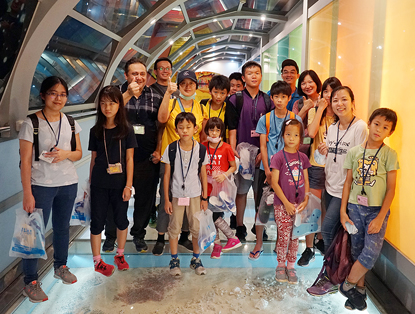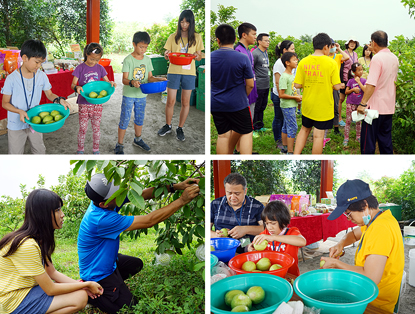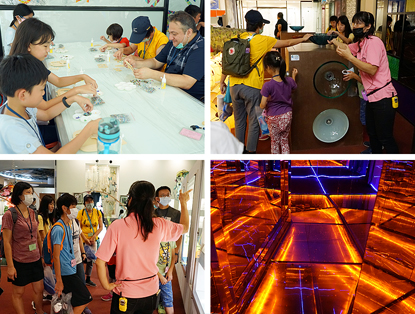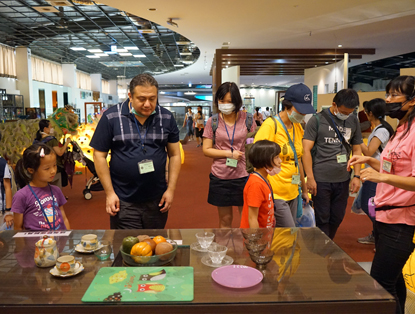Sketch of Archilife Study Tour, August 2020Date: 2020-09-26
Section: Activity |  8月份見識之旅活動,於2020年8月22日由呂明澐小姐帶領15位祐生見習生及家長們,進行彰化田中芭樂小學堂暨玻璃藝術體驗之旅。活動開始之初,領隊呂明澐小姐提醒本次活動注意事項及觀察重點,先行建立見習生的背景知識。 8月份見識之旅活動,於2020年8月22日由呂明澐小姐帶領15位祐生見習生及家長們,進行彰化田中芭樂小學堂暨玻璃藝術體驗之旅。活動開始之初,領隊呂明澐小姐提醒本次活動注意事項及觀察重點,先行建立見習生的背景知識。
For the study tour of August 22, 2020, Ms Lu Ming-yun led 15 ARF interns and their parents on a trip to Tianzhong, Zhanghua, to learn about guava and glass art. At the start of the day's activities, team leader Ms. Lu Ming-yun reminded everyone about things to note and what to observe, and gave the interns some background knowledge.
 上午行程參訪菁芩芭樂休閒農場。行程一開始,農場主人邀請眾人試吃芭樂,透過味覺及視覺認識不同品種的口感與外觀。其中,一般市面上的紅心芭樂是紅色果肉芭樂的統稱,尚有區分西瓜芭樂、胭脂芭樂等品種。芭樂富含許多營養價值,其中維他命C是奇異果的30倍,亦被證實含有茄紅素、多酚等抗氧化物質,具有防癌效果。接著進行甘草芭樂DIY,農場主人教導製做的步驟與要訣,好吃的秘密在於搖晃芭樂時,須注意糖粉附著的均勻程度,搖晃越多下越入味,過程中舉辦搖擺王大賽,考驗見習生製做甘草芭樂的功力,增添活動趣味性。活動結束後,眾人前往一旁果園導覽,由農場主人介紹該果園以草生栽培方式種植,不使用除草劑,定期以除草機人工除草。此外,東方果實蠅為芭樂的主要害蟲,必須在幼果期套袋防止蟲害,避免果實腐壞。隨即解說芭樂從授粉開花到結果實的歷程,並指出樹上的花苞與剛長出的果實,讓眾人能實際觀察不同時期的成長狀態。 上午行程參訪菁芩芭樂休閒農場。行程一開始,農場主人邀請眾人試吃芭樂,透過味覺及視覺認識不同品種的口感與外觀。其中,一般市面上的紅心芭樂是紅色果肉芭樂的統稱,尚有區分西瓜芭樂、胭脂芭樂等品種。芭樂富含許多營養價值,其中維他命C是奇異果的30倍,亦被證實含有茄紅素、多酚等抗氧化物質,具有防癌效果。接著進行甘草芭樂DIY,農場主人教導製做的步驟與要訣,好吃的秘密在於搖晃芭樂時,須注意糖粉附著的均勻程度,搖晃越多下越入味,過程中舉辦搖擺王大賽,考驗見習生製做甘草芭樂的功力,增添活動趣味性。活動結束後,眾人前往一旁果園導覽,由農場主人介紹該果園以草生栽培方式種植,不使用除草劑,定期以除草機人工除草。此外,東方果實蠅為芭樂的主要害蟲,必須在幼果期套袋防止蟲害,避免果實腐壞。隨即解說芭樂從授粉開花到結果實的歷程,並指出樹上的花苞與剛長出的果實,讓眾人能實際觀察不同時期的成長狀態。
The morning's itinerary brought everyone to Jing Qin Guava Recreational Farm. At the start of the tour, everyone was invited to sample some guava, and learn to identify the texture and appearance of different species through taste and sight. The "red heart" guava commonly seen in the market is the general name for red flesh guava, which includes watermelon guava and rouge guava. Guava is rich in nutrients. In particular, it has 30 times more vitamin C than kiwi fruit and has been proven to contain lycopene and polyphenols, which can help prevent cancer. In the DIY session, the farm owner taught everyone the steps and tips to making liquorice guava. The secret to tasty liquorice guava is to make sure the powdered sugar coats the guava evenly when the guava pieces are shaken. The more times the guava pieces are shaken, the more flavor they will have. During the session, the interns also competed to be the best at making liquorice guava, adding more fun to the activity. Following the DIY session, everyone visited a nearby orchard. The farm owner explained that the orchard uses cultural weed control rather than herbicide and weed is regularly removed using a mower. As the oriental fruit fly is the major pest of guava, the guava fruits must be bagged during their early growth stage to prevent pests and fruit rotting. The farm owner also explained the process from pollination, flowering to fruiting, and pointed out the buds and young fruits on the trees, allowing everyone to observe the different stages of growth.
 下午前往台灣玻璃博物館參訪。首先由導覽人員帶領眾人進行琉璃珠相框DIY。隨後進入黃金隧道,體驗利用玻璃的透光折射營造出空間與視覺上的錯置感。接著進行館內解說,導覽人員說明目前科技發展迅速,玻璃在建築運用上除了採光、通風之外,更結合電子技術與光學原理,讓玻璃得藉由電源轉換,形成白色霧化效果,如電控調光玻璃,使辦公室或居家裝潢有更多樣彈性的選擇。最後來到琉璃工藝展示區,導覽人員說明琉璃雖是玻璃的一種,因添加氧化鉛令其透光度較一般玻璃好而有水晶玻璃之稱,加熱軟化時得拉成細絲,可見其可塑性極高,適合發展工藝品,亦於現場觀看本土琉璃藝術家吹拉塑形的過程,眾人皆驚嘆不已。至此,本日活動已近尾聲,大家一起合照留念後搭車返程,並期待於下次見識之旅再相見。 下午前往台灣玻璃博物館參訪。首先由導覽人員帶領眾人進行琉璃珠相框DIY。隨後進入黃金隧道,體驗利用玻璃的透光折射營造出空間與視覺上的錯置感。接著進行館內解說,導覽人員說明目前科技發展迅速,玻璃在建築運用上除了採光、通風之外,更結合電子技術與光學原理,讓玻璃得藉由電源轉換,形成白色霧化效果,如電控調光玻璃,使辦公室或居家裝潢有更多樣彈性的選擇。最後來到琉璃工藝展示區,導覽人員說明琉璃雖是玻璃的一種,因添加氧化鉛令其透光度較一般玻璃好而有水晶玻璃之稱,加熱軟化時得拉成細絲,可見其可塑性極高,適合發展工藝品,亦於現場觀看本土琉璃藝術家吹拉塑形的過程,眾人皆驚嘆不已。至此,本日活動已近尾聲,大家一起合照留念後搭車返程,並期待於下次見識之旅再相見。
 The afternoon's itinerary was a visit to the Taiwan Glass Gallery. The tour began with a DIY session to make glass bead photo frames, followed by a walk through the "golden tunnel", which is specially designed using the transparency and refraction of glass to create spatial and visual distortion. Inside the gallery itself, the tour guide explained that, due to rapid technological development, glass is not only used for capturing light and ventilation purpose in construction but also has other uses that take advantage of electronic technology and optical principles. For instance, a white fog effect may be created through power conversion, producing switchable glass which provides more versatility for office and home décor. In the glass art showcase area, the tour guide explained that crystal is a type of glass but has greater light transmittance because of the addition of lead oxide. It may be pulled into fine threads when heated and soft, and is suitable for making artworks as it is highly sculptable. Everyone was also awed by live demonstration of glass blowing technique by local artists. At this point, the day's itinerary came to an end. Everyone took a group photo before heading back and looked forward to the next study tour. The afternoon's itinerary was a visit to the Taiwan Glass Gallery. The tour began with a DIY session to make glass bead photo frames, followed by a walk through the "golden tunnel", which is specially designed using the transparency and refraction of glass to create spatial and visual distortion. Inside the gallery itself, the tour guide explained that, due to rapid technological development, glass is not only used for capturing light and ventilation purpose in construction but also has other uses that take advantage of electronic technology and optical principles. For instance, a white fog effect may be created through power conversion, producing switchable glass which provides more versatility for office and home décor. In the glass art showcase area, the tour guide explained that crystal is a type of glass but has greater light transmittance because of the addition of lead oxide. It may be pulled into fine threads when heated and soft, and is suitable for making artworks as it is highly sculptable. Everyone was also awed by live demonstration of glass blowing technique by local artists. At this point, the day's itinerary came to an end. Everyone took a group photo before heading back and looked forward to the next study tour.
|
|